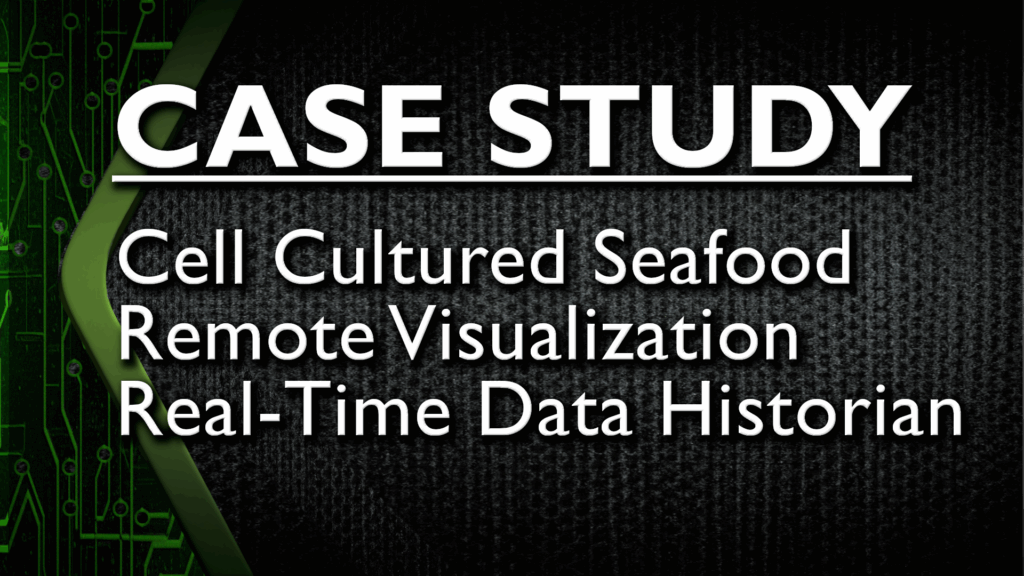Case Study: Cell Cultured Seafood Remote Visualization and Historian
1 | Executive Summary
Accelerating Lights Out Cultivated Seafood Production with Mobile Data Infrastructure
Wildtype Foods, a leader in cultivated seafood, engaged Lucid Automation to validate whether real‑time data capture and remote visualization could push their new San Francisco pilot plant closer toward an autonomous, lights‑out manufacturing model.
The existing validated bioreactor equipment runs on a proprietary control system and was not to be modified. The impact to the plant and enterprise networks was also to be minimized as operations were ongoing.
In a two‑week sprint Lucid delivered a mobile, rugged, self-contained server that bolted onto Wildtype’s network to pull bioreactor data into a FactoryTalk Historian SE / PI Vision stack. These components generated electronic batch reports (EBRs), dashboards, and trends for engineers monitoring production runs.
Installation of the servers and connections to the existing equipment on site took less than a day and was not disruptive to operations. Before departing, remote access was enabled and tested.
During the 28-day production run, process engineers and QA staff monitored the culture remotely, validated critical parameters, and recognized the potential to reduce onsite monitoring and report-preparation time.
The outcome of the two-week test surprised us. While we successfully bolted on historian and process-data visualization, we also discovered that with a bit more work this approach can have much greater impact with streamlining electronic batch reporting and facilitating a future end state of lights-out production for cell cultivation.
The pilot experiment confirmed that a phased, low‑risk upgrade path can accelerate Wildtype’s vision of highly automated, sustainable protein manufacturing.
2 | Background & Challenge
For manufacturers pursuing sustainability, progress starts with a solid business case and a phased roadmap: automate one line, validate the gains, then scale deliberately. Since a lights-out factory influences every function, committed leadership and adequate resources are essential to make the vision real.

Reviewing the overall process, cell cultivation proved to be the most impactful place to start as the longest-running process step. Fully automating cell cultivation with remote monitoring would be a large step towards the strategic vision while also establishing the data systems to support quality compliance.
- Wildtype’s need: Growing batch volumes outpaced the visibility their mixed-vendor control layer could provide. Engineers wanted live dashboards and historical trends without modifying the commercial-off-the-shelf equipment, rearchitecting the plant network, or adding IT overhead.
- Industry context: Cultivated-meat producers aim to fuse bioprocessing discipline with the efficiency of dark (lights-out) factories. Continuous, sterile operation and stringent quality demands make robust data infrastructure essential.
- Competitive advantage: In a market dominated by conventional protein, automation is the clearest path to scaling production while reducing overhead. Lights-out infrastructure supports higher uptime, quality improvements, and lower cost per kilogram as key steps toward price parity and long-term viability.
3 | Solution: Lucid Pro Station “Bolt‑On” Data Integrity Stack
The quickest way to deliver infrastructure-grade servers and services to Wildtype’s plant network was to deploy Lucid Automation’s PRO Station rugged mobile kit.
Its compact footprint fit neatly in the IT room. Loading it with Rockwell FactoryTalk Historian SE and PI Vision on virtual servers gave us everything we needed to start secure data collection and real-time trend visualization.

No client software was required to be installed. Authorized users simply connected over VPN and pulled a web browser session to access the system.
| Component | Purpose |
| Virtualized server (on-prem, mobile enclosure) | Isolates all software, rolls in on casters, & plugs into 120 V outlet. |
| FactoryTalk Historian SE (OSIsoft PI engine) | Collects, compresses, & time‑stamps bioreactor tags. |
| PI Vision | Secure web dashboards for live & historical views. |
| Layer 2/3 managed switches + VPN | Creates a DMZ; no changes to Wildtype’s OT or enterprise firewalls. |
Key parameters logged: temperature, pH, dissolved O₂, pressure, gas-flow rates, batch phase state, and CIP/SIP cycles.
Lucid mapped 100 + Siemens-PLC and proprietary‑HMI tags, built interactive PI Vision screens (trends, P&ID overlays, batch phase), and trained engineers in under a week on site.
4 | Results
The system performed as expected, providing engineers remote access to the tags available through the Siemens PLC. A full 28 day run was captured and accessed via the web-based trends and overview graphics.
| Outcome | Impact |
| Full 28–day run captured | Continuous historian record for trending or electronic batch reporting |
| Remote monitoring enabled | Process engineers reduced on-site walk-downs; QA reviewed data from home. |
| EBR prototype delivered | Automated comparison of historian data to QA limits has potential to cut report prep time. |
| Network risk = zero | Isolated VLAN; no disruption to production controls. |
| Scalable foundation | Same stack capable of additional bioreactors, CIP, utilities, and downstream skids. |
The screens available to operators were a real-time P&ID overview and configurable trend. The screens were accessible over VPN and a secured web browser. Screen shots of both are below.


-Real Time, web-based PI Vision Dashboard showing P&ID overview and historical trend screens
5 | Strategic Impact
While this does not immediately enable a lights-out implementation, in just a 2 month sprint a foundation has been laid and a detailed path forward has been identified for incremental improvement towards that goal.
- Toward lights–out: Data infrastructure is the gateway to automated feeding, adaptive control, and eventually automatic sampling. These are core building blocks of a dim-to-dark factory.
- Sustainability & cost: Higher uptime, tighter control, and fewer manual interventions, lower energy per kg, reduced consumables, and accelerated cost parity with conventionally farmed seafood.
- Low‑risk path: Lucid’s bolt-on approach proves incremental upgrades can deliver immediate ROI while preserving equipment validation status and cybersecurity posture.
Towards the strategic goals of quality and sustainability, adding automated sampling and unlocking access to proprietary HMI data enables predefined batch reports. Collaborating with process development, engineering, and QA teams ensures “release‐by‐exception” cuts decision time, lowers inventory costs, and boosts profitability while maintaining the highest quality standards.
The experiment’s success shone a spotlight on the limits of a two-month study and underscored the system’s future potential.
- There was a significant amount of process and batch data stored in the proprietary system.
- The proprietary data would need to be accessed by programmatic API calls, either in real time or mirrored to an open database platform.
- The value in accessing bioreactors remotely for either real-time or historical data would be increased with multiple equipment units on the system.
- Cell sampling would need to be integrated or fully automated to take the cell culture phase to a lights-out process.
6 | Next Steps
The results held the promise of more gains to be had. The value of this architecture is there, but the limited data available in the PLC alone revealed additional contextual event frame information from the proprietary HMI and recipe manager would be needed to fully model the process.
Incorporating additional equipment and retrieving data via API calls to the proprietary HMI will significantly enhance the system’s impact for process engineers.
- Incorporating Non-PLC data with API calls to proprietary HMI & recipes
- Onboard additional upstream reactors into a single-pane PI Vision dashboard.
- Automate sampling & material transfers with skid-level PLC handshakes.
- Add Data analytics/AI for predictive quality (cell density, metabolite trends).
- Integrate with MES/LIMS to close the batch‑release loop.
7 | Conclusion
This historian pilot proves that cultivated meat facilities can achieve immediate gains in visibility, compliance, long-term market viability, and labor efficiency without a plant-wide retrofit. By combining Lucid’s automation expertise with Wildtype’s vision for sustainable protein, the team has taken a concrete step from theory to practice on the lights‑out journey.
It is the correct path and the phased approach is appropriate to implementing this powerful tool as the process develops.
With a strong commitment to sustainability and the determination to realize their strategic vision, Wildtype Foods is emerging as a leader in this space. Lucid Automation is proud to be a trusted partner in bringing that vision to life.
Lucid Automation Resources Page


